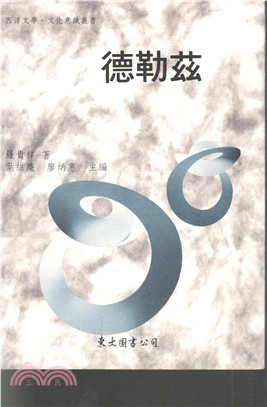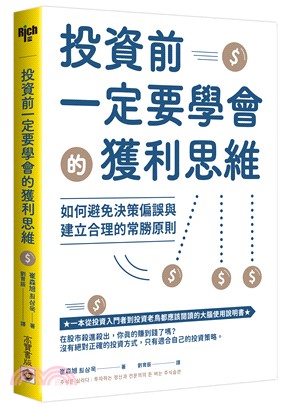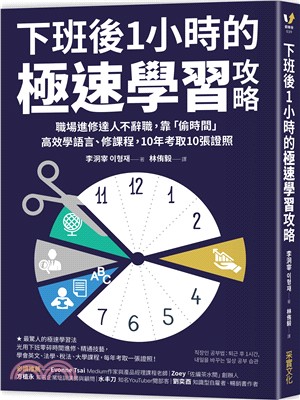Honsberger revisited:mathematical gems polished
- 系列名:通識系列
- ISBN13:9789860311686
- 出版社:臺大出版中心
- 作者:LIONG-SHIH HAHN
- 裝訂/頁數:平裝/320頁
- 規格:23cm*17cm (高/寬)
- 出版日:2011/12/01
再享89折,單本省下48元
商品簡介
The author's purpose is to share the thrills and excitement of ingenious solutions to intriguing elementary problems that he has had the good fortune to have conceived in the pursuit of his passion over many years. His satisfaction lies in the beauty of these gems, not in the incidental fact that they happen to be his own work. A wonderful solution is a glorious thing, whoever might have thought of it, and the author has worked diligently to make easy reading of the joy and delights of his often hard-won success.
As Director, responsible for composing the problems for the New Mexico Mathematics Contest before his retirement, the author consulted the wonderful books by Professor Ross Honsberger whenever he needed an inspiration. As a result, the New Mexico Mathematics Contest rose to national prominence and the author received the “Citation for Public Service” from the American Mathematical Society in 1998. In this volume he collected his treatments of over a hundred problems from the treasure trove of Professor Honsberger.
Perhaps it is best to quote Professor Honsberger, “This is a book for everyone who delights in the richness, beauty, and excitement of the wonderful ideas that abide in the realm of elementary mathematics. I feel it is only fair to caution you that this book can lead to a deeper appreciation and love of mathematics.”
中文說明
本書(中譯名:重訪亨斯貝爾格--磨亮數學寶石)是美國 New Mexico 大學退休教授 Liong-Shin Hahn(韓良信)從著名數學家 Ross A Hongsberger 所著的五本書中選出好題目,加以探索、分析、解題、延伸之後,寫下的一本「讀數」札記。
Hongsberger 的這五本書分別是(1) Mathematical Delights(2004出版) (2) In Polya's Footsteps(1997出版) (3) Mathematical Chestnuts from around the world(2001出版) (4) Mathematical Diamonds(2003出版) (5) From Erdös to Kiev(1996出版)。
韓教授將上述這五本書的書名作為本書的章名,每一章的題目都是從 Hongsberger 對應的書中挑出來的,並且提供了比原書更好,更精緻,且更具啟發性的解法。作者特別強調「重訪」這本書完全可以獨立閱讀,當然也可以與 Hongsberger 的原書平行閱讀。
除了上述五章本文之外,「重訪」一書另有A、B、C三個附錄。附錄A收集了115個挑戰題,粗分為52題幾何題,20題代數題,18題數論題,20題組合題和5題微積分題,解題所需的工具是高中數學。
附錄B是對附錄A的詳解。附錄C是整本「重訪」一書解題所需的定理,作者將這些定理作了很好的證明和延伸,這些定理包含了中學教育最核心的議題:
c.1 三角形相關定理
c.2 圓形相關定理
c.3 三角學相關定理
c.4 圓錐曲線相關定理
c.5 Jensen不等式的各種面貌
本書不單是一本解題手冊,而是藉解題來呈現作者認為最重要的數學,適合對數學有興趣的高中生、大學生以及中學的數學教師研讀。
作者簡介
Liong-shin Hahn was born into a family of physicians in Tainan, Taiwan. He calls himself the black sheep of the family, because, like his father, Shyr-Chyuan Hahn, M.D., Ph.D., all five of his brothers became physicians. After graduating from Tainan First Senior Middle School and the National Taiwan University, he attended Stanford University and obtained his Ph.D. there under Professor Karel deLeeuw. He spent most of his career at the University of New Mexico, and while away from that institution, he held visiting positions at the University of Washington (Seattle), the National Taiwan University, the University of Tokyo, Sophia University (Tokyo) and the International Christian University (Tokyo). As director of the mathematics contest sponsored by the University of New Mexico, he consulted frequently the superb books by Professor Ross Honsberger that seeded the birth of this book. He authored Complex Numbers and Geometry (Mathematicial Association of Americia, 1994), New Mexico Mathematics Contest Problem Book (University of New Mexico Press, 2005), and co-authored with Bernard Epstein Classical Complex Analysis (Jones and Bartlett, 1996). He was awarded the Citation for Public Service from the American Mathematical Society in 1998. His marriage to Hwei-Shien Lee (yet another M.D.) yielded three sons and seven grandchildren.
序
序言
Before my retirement, I was responsible for composing the problems for the New Mexico Mathematics Contest1. Whenever I needed an inspiration then, I always turned to the wonderful books by Professor Ross Honsberger. I knew his books were a treasure trove of interesting problems with brilliant solutions. So it was only natural that when I retired and wanted to prevent dementia, I chose problems from his books for my “Problem-of-the-Day” activity. I would not peek at the solution unless I had solved the problem myself, or could not come up with a fresh approach to tackle the problem for at least 72 hours. The problem-of-the-day activity gave me a daily drama. Some days, I was delighted to have found nice solutions, but some other days I was disappointed that my “brilliant” solutions turned out to be essentially the same as those presented in his books, or worse, not so brilliant compared to the published ones.
Time and again, Professor Honsberger encouraged me to publish my solutions. This book is the consequence. I can only claim I found these solutions myself. But as it is irrelevant for my problem-of-the-day activity, no effort is made to check whether they are new. Naturally, my solutions that have already appeared in Professor Honsberger's books are excluded. On the other hand, some solutions that are not so elegant are included, in the hope that they still have some merits. By the way, my original plan was to include also Episodes in Nineteenth and Twentieth Century Euclidean Geometry, which is another very rich source for exploration. However, my manuscript is already over 300 pages, and the inclusion would make this one too lopsided toward geometry. Furthermore, after five years on this book project, I am eager to move on to the next phase of my life.
Each chapter corresponds to Professor Honsberger's book with the same title. However, the order of the chapters is random, and so they can be read in any order. Yet, in Exercises (Appendix A) and Solutions (Appendix B), I preserve the order in Professor Honsberger's books for easy reference. The source of each problem is identified by a single or a pair of number(s) in brackets. For example, because Chapter 2 corresponds to In P´olya's Footsteps, so a problem taken from page 67 of In P´olya's Footsteps is indicated by [67] in Chapter 2, while this same problem is referred to in other chapters by [2:67]. None of the problems in Exercises (Appendix A)1See my book, New Mexico Mathematics Contest Problem Book (University of New Mexico Press, 2005).popped out of thin air. If they have appeared in Professor Honsberger's books, then alternate solutions can be found in Solutions (Appendix B). Others are byproducts of my solutions. Therefore, all have their origins, directly or indirectly, in Professor Honsberger's works. Appendix C is designed to provide sufficient background for the readers. It contains my favorite “tools of the trade”.
I am an unabashed admirer of the late Professor George P´olya, mainly for the elegance of his mathematics, but also for his teaching and problem-solving methods, not to mention his devotion to mathematics education.
I keep on telling students whenever I have a chance: “If you find a book by Professor P´olya, buy it and read it. You will be happy you did.” His books are invaluable for anyone in mathematics, both in teaching and in research. I only wish I had a chance to hear his comments on my solutions. I am sure many readers can detect his influence on me.
Although Professor Honsberger's books are not a necessary background; i.e., this book can be read independently, I am sure, by parallel reading, the reader will be all the more entertained. And I certainly hope that readers who enjoy his books will also enjoy mine. At the minimum, I hope I have some success in conveying the joy of problem solving.
It is a pleasure to express my heartfelt appreciation to Professor Honsberger for his friendship over the decades, and his encouragement throughout this book project. I can never thank him enough for his very meticulous reading of the manuscript and generous help in improvement of the presentation, not to mention his endorsement in the Introduction.
L.-s. H.
February 2008
Postscript. It is a pleasure to express my deep appreciation to Dr. Luke Cheng-chung Yu (neonatology and pediatric cardiology, board certified) and my son, Shin-Yi, for their help in solving the computer problems for me. Without their help, I don’t know how long the publication of this book would have been delayed. Even though the manuscript was completed in February 2008, it was submitted to the National Taiwan University Press three years later. Knowing the book will be published within one year was a happy surprise for the author. Now the fortunate result is before you.
導讀(作者或專家所寫)
Introduction
What is it about math problems that makes them so addictive?
When I get going on a problem, I’d rather stay at it than eat!
Liong-shin Hahn and I are kindred spirits who have lived like this for the last fifty years. As you might expect, Liong-shin has become very adept at solving problems, and in this volume he has collected his treatments of some hundred problems that caught his eye in my books. If you would like a sample of his ingenuity, take a look at Exercise 49 (pages 149 and 215) or his solution to Exercise 8 (pages 138 and 177); and wait till you see what Problem 2.1 (page 29) conjured up in his mind!
While this volume might be used in the training of young scholars to write mathematics contests, it is more than that. This is a book for everyone who delights in the richness, beauty, and excitement of the wonderful ideas that abide in the realms of elementary mathematics. I feel it is only fair to caution you that this book can lead to a deeper appreciation and love of mathematics.
Without further ado, then, let us turn over the stage to this remarkable man—Liong-shin Hahn.
By Ross Honsberger.
目次
Introduction vii
Preface viii
1 Mathematical Delights 1
1.1 Triangles in Orthogonal Position 1
1.2 Pan Balance 6
1.3 Schoch 3 7
1.4 A Nice Problem in Probability 10
1.5 Three Proofs of the Heron Formula 13
1.6 Incenter 18
1.7 On Median, Altitude and Angle Bisector 19
1.8 A Geometry Problem from Quantum 23
1.9 Monochromatic Triangle 25
1.10 Sum of the Greatest Odd Divisors 26
1.11 Prime Numbers of the Form m2k + mknk + n2k 27
2 In P olya's Footsteps 29
2.1 Curious Squares 29
2.2 A Problem from 15th Russian Olympiad 32
2.3 Maximum Without Calculus 34
2.4 Cocyclic Points 36
2.5 Reconstruction of the Original Triangle 37
2.6 The Sums of the Powers 38
2.7 A Problem from Crux Mathematicorum 46
2.8 A Puzzle 47
2.9 Pedal Triangle with Preasigned Shape 47
2.10 An Intriguing Geometry Problem 49
3 Mathematical Chestnuts from Around the World 52
3.1 Three Similar Triangles Sharing a Vertex 52
3.2 The Simson Line in Disguise 55
3.3 Circle through Points 56
3.4 Zigzag 57
3.5 Cevians 60
3.6 Integers of a Particular Type Divisible by 2n 61
3.7 Quadrangles with Perpendicular Diagonals 61
4 Mathematical Diamonds 64
4.1 Orthic Triangle 64
4.2 Quartering a Quadrangle 66
4.3 A Well-Known Figure 67
4.4 Rangers with Walkie-Talkie 71
4.5 A Piston Rod 73
4.6 The Schwab-Schoenberg Mean 75
4.7 Construction of an Isosceles Triangle 79
4.8 The Conjugate Orthocenter 82
4.9 A Remarkable Pair 85
4.10 Calculus? 89
4.11 A Problem from the 1980 Tournament of Towns 91
5 From Erdos to Kiev 96
5.1 The Sum of Consecutive Positive Integers 96
5.2 A Problem in Graph Theory 98
5.3 A Triangle with its Euler Line Parallel to a Side 99
5.4 A “Pythagorean” Triple 102
5.5 A Geometry Problem from the K¨ursch´ak Competition 104
5.6 A Lovely Geometric Construction 109
5.7 A Problem from the 1987 Austrian Olympiad 112
5.8 Another Problem from the 1987 Austrian Olympiad 116
5.9 An Unexpected Property of Triangles 119
5.10 Products of Consecutive Integers 125
5.11 A Problem from the Second Balkan Olympiad, 1985 129
A Exercises 136
B Solutions 166
C Useful Theorems 288
C.1 Triangles 288
C.1.1 Complex Plane 288
C.1.2 Corollaries 290
C.1.3 Equilateral Triangles 291
C.1.4 Theorems of Ceva and Menelaus 291
C.2 Circles 294
C.2.1 Subtended Angles 294
C.2.2 The Power Theorem 297
主題書展
更多主題書展
更多書展本週66折
您曾經瀏覽過的商品
購物須知
為了保護您的權益,「三民網路書店」提供會員七日商品鑑賞期(收到商品為起始日)。
若要辦理退貨,請在商品鑑賞期內寄回,且商品必須是全新狀態與完整包裝(商品、附件、發票、隨貨贈品等)否則恕不接受退貨。

























